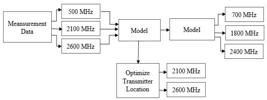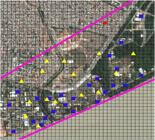Abstract
A good wireless network design depends on technical and financial viability and a number of other criteria that must be met. Following the emergence of new technologies and services, such as 5G transmission and the reuse of frequencies, new work is being carried out to ensure a better design for a particular area. This study examines a discrete radio propagation model which employs the K nearest neighbors classifier. The model takes into account the different characteristics of the environment. This article presents a case study for the optimum positioning of base stations in Federal University of Pará (Belém – Brazil), representing a typical Amazon environment. The mentioned scenario is heterogeneous, presenting edifications and considerable forest area. Measurement campaigns were conducted in three different frequencies for the design features of the model: 521 MHz (Brazilian digital TV system), 2100 MHz (Enhanced Data Rates for GSM Evolution), and 2600 MHz (Long Term Evolution). A study of the fading phenomenon in these frequencies was carried out to generalize the frequencies of application for the propagation loss model. When this model was ready, tests (computing simulations) were conducted in two scenarios to optimize the positioning of the radio base stations being studied.
Index Terms
Antenna Positioning; KNN Classifier; Optimization; Radio Propagation Models; Refarming

 Thumbnail
Thumbnail
 Thumbnail
Thumbnail
 Thumbnail
Thumbnail
 Thumbnail
Thumbnail
 Thumbnail
Thumbnail
 Thumbnail
Thumbnail
 Thumbnail
Thumbnail
 Thumbnail
Thumbnail
 Thumbnail
Thumbnail
 Thumbnail
Thumbnail









